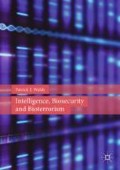Abstract
This chapter discusses how traditional intelligence collection platforms (sigint and humint) have been applied to understand bio-threat and risks. The strengths and weaknesses of each platform is discussed, however the chapter argues other scientific sources of intelligence (forensics and epidemiology) are likely to be more useful in gaining greater understanding of potential emerging bio-threats and risks. The chapter also argues for a more systematic approach to collection against bio-threats and risks—one that considers what is required at strategic, operational and tactical levels.
Access this chapter
Tax calculation will be finalised at checkout
Purchases are for personal use only
References
9/11 Commission. (2004). The 9/11 Commission Report: Final Report of the National Commission on Terrorist Attacks Upon the United States. Washington, DC: 9/11 Commission.
Bean, H. (2007). The DNI’s Open Source Center: An Organizational Communication Perspective. International Journal of Intelligence and Counterintelligence, 20(2), 240–257.
Bombardt, J. (2000). Contagious Disease Dynamics for Biological Warfare and Bioterrorism Casualty Assessments. Alexandria, VA: U.S. Department of Defense.
Chertoff, M. (2017). A Public Policy Perspective of the Dark Web. Journal of Cyber Policy, 2(1), 26–38. https://doi.org/10.1080/23738871.2017.1298643.
Crumpton, H. (2012). The Art of Intelligence: Lessons from a Life in the CIA’s Clandestine Service. New York: Penguin Publishing Group.
DOJ. (2010). The United States Department of Justice. Amerithrax Investigative Summary. Washington, DC.
GAO. (2017). Bio Forensics DHS Needs to Conduct a Formal Capability Gap Analysis to Better Identify and Address Gaps. Washington, DC: GAO.
Gill, P., & Phythian, M. (2012). Intelligence in an Insecure World. Cambridge: Polity Press.
Gordis, L. (2009). Epidemiology (4th ed.). Philadelphia, PA: Saunders Elsevier.
Hayden, M. (2016). Playing to the Edge. New York: Penguin Press.
Hulnick, A. (2002). The Downside of Open Source Intelligence. International Journal of Intelligence and Counterintelligence, 15(4), 565–579.
Inglis, T., et al. (2011). Forensic Investigation of Biological Weapons Use. In J. Gall & J. Payne-James (Eds.), Current Practices in Forensic Medicine (pp. 17–42). Chichester, UK: Wiley.
Johnson, L. (2017). National Security Intelligence. Cambridge, MA: Polity Press.
Johnson, L., & Wirtz, J. (Eds.). (2015). Intelligence: The Secret World of Spies. New York: Oxford University Press.
Johnson, L., et al. (2014). An INS Special Forum: Implications of the Snowden Leaks. Intelligence and National Security, 29(6), 793–810.
Kim, J., et al. (2015). Advances in Anthrax Detection: Overview of Bioprobes and Biosensors. Applied Biochemistry and Biotechnology, 176(4), 957–977.
Koblentz, G., & Tucker, J. (2010). Tracing an Attack: The Promise and Pitfalls of Microbial Forensics. Survival, 52(1), 159–186. https://doi.org/10.1080/00396331003612521.
Lee, M. (2017, January 5). Julian Assange’s Claim That There Was No Russian Involvement in Wikileaks Emails. The Washington Post. From https://www.washingtonpost.com/news/fact-checker/wp/2017/01/05/julian-assanges-claim-that-there-was-no-russian-involvement-in-wikileaks-emails/?utm_term=.bee14c837aef. Accessed March 15, 2017.
Lowenthal, M. (2012). Intelligence from Secrets to Policy. Thousand Oaks, CA: CQ Press.
McGurry, J. (2017). Volleyball Games Appear to Take Place at North Korean Nuclear Test Site. The Guardian. From https://www.theguardian.com/world/2017/apr/20/north-korea-volleyball-nuclear-test-site-punggye-ri. Accessed March 15, 2017.
Mercado, S. (2014). Open Source Intelligence. In L. Johnson & J. Wirtz (Eds.), Intelligence: The Secret World of Spies (4th ed., pp. 120–129). New York: Oxford University Press.
Murch, R. (2003). Microbial Forensics: Building a National Capacity to Investigate Bioterrorism. Biosecurity and Bioterrorism: Biodefense Strategy, Practice, and Science, 1(2), 1–5.
Office of Inspectors General DOD, CIA, NSA, ODNI, & DOJ. (2009). Report on the President’s Surveillance Program Volume 1. Washington, DC.
Omand, D., et al. (2012). Introducing Social Media (SOCMINT) Intelligence. Intelligence and National Security, 27(6), 801–823.
Oppel, R., et al. (2010, January 4). Attacker in Afghanistan Was a Double Agent. The New York Times. From http://www.nytimes.com/2010/01/05/world/asia/05cia.html. Accessed March 15, 2017.
Redmond, P. (2015). The Challenges of Counterintelligence. In L. Johnson & J. Wirtz (Eds.), Intelligence the Secret World of Spies (4 ed., pp. 305–316). New York: Oxford University Press.
Risen, J., & Lichtblau, E. (2005). Bush Lets US Spy on Callers Without Courts. The New York Times. From http://www.nytimes.com/2005/12/16/politics/bush-lets-us-spy-on-callers-without-courts.html. Accessed March 15, 2018.
Rovner, J. (2013). Intelligence in the Twitter Age. International Journal of Intelligence and Counterintelligence, 26(2), 260–271.
Shea, D. (2006). The National Biodefense Analysis and Countermeasure Center: Issues for Congress CRS Report (Vol. RL32891). Washington, DC: Congressional Research Service, The Library of Congress.
Sims, J., & Gerber, B. (2009). Vaults Mirrors and Masks Rediscovering US Counterintelligence. Washington, DC: Georgetown University Press.
Tucker, J., & Koblentz, G. (2009). The Four Faces of Microbial Forensics. Biosecurity and Bioterrorism: Biodefense Strategy, Practice, and Science, 7(4), 389–397. https://doi.org/10.1089/bsp.2009.0043.
Van Cleave, M. (2007). Counter Intelligence and National Security. Washington, DC: National Defense University.
Vogel, K. (2013). Phantom Menace or Looming Danger?. Baltimore, MD: The Johns Hopkins University Press.
Walsh, P. F. (2011). Intelligence and Intelligence Analysis. Abingdon, UK: Routledge.
Walsh, P. F., & Miller, S. (2016). Rethinking ‘Five Eyes’ Security Intelligence Collection Policies and Practice Post Snowden. Intelligence and National Security, 31(3), 345–368.
Walsh, P. F. (2017). Drone Paramilitary Operations Against Suspected Global Terrorists: US and Australian Perspectives. Intelligence and National Security, 32(4), 429–433.
Author information
Authors and Affiliations
Corresponding author
Copyright information
© 2018 The Author(s)
About this chapter
Cite this chapter
Walsh, P.F. (2018). Collection. In: Intelligence, Biosecurity and Bioterrorism. Palgrave Macmillan, London. https://doi.org/10.1057/978-1-137-51700-5_4
Download citation
DOI: https://doi.org/10.1057/978-1-137-51700-5_4
Published:
Publisher Name: Palgrave Macmillan, London
Print ISBN: 978-1-137-51699-2
Online ISBN: 978-1-137-51700-5
eBook Packages: Law and CriminologyLaw and Criminology (R0)

